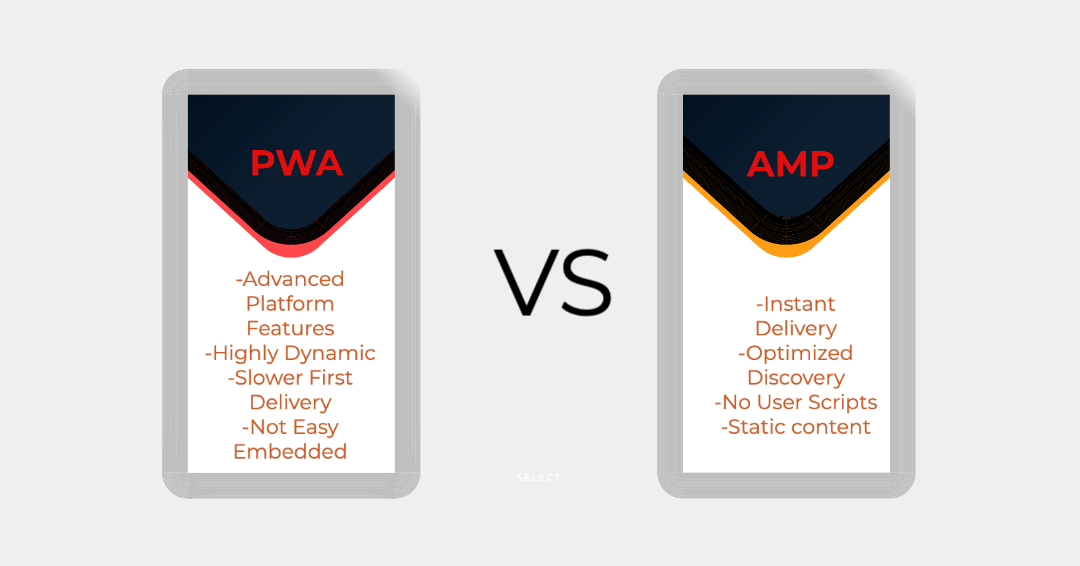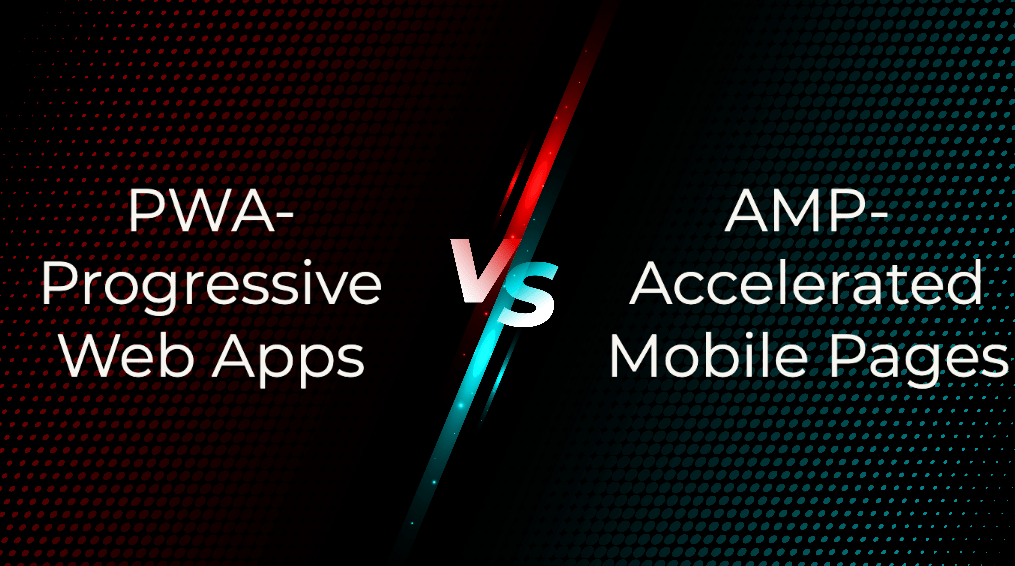Progressive web apps VS AMP pages
Progressive web apps
Progressive web apps feature modern web technologies such as the App Shell model to suggest modern browsing features, making them look like a regular mobile applications. In addition, PWA deploys an array of design concepts, the unique qualities that contemporary browsers support, and technologies and Web APIs that work together to supply the finest eCommerce websites and mobile apps. In other words, they are advanced versions of responsive web apps that contain all the additional components of a good app.

Significant Features of PWA
- Compatible: These web apps are highly consistent with all devices, including mobile devices, tablets, and desktops.
- Progressive: As the name signifies, these apps are developed, i.e. they work nicely in every browser.
- Connectivity: It allows the users to work offline or on deficient networks.
- Up-to-date: The Service Worker update procedure assures seamless offline functionality, content caching, push messages, background content updating, and much more.
- Content Loading: PWA suggests more rapid load time and smooth animations and navigations.
- Secure: These web apps consistently have an HTTPS certificate that encodes your data between browser and webserver to provide safe content.
- Shareable: You can readily share these with URLs. It doesn’t need installations.
- Bookmark: Users can effortlessly pin their favourite web apps instantly to their home screens without obtaining the annoyance of downloading them via app stores. With more occasional clicks and augmented convenience for the users, these apps improve an excellent conversion rate.

Pros Of PWA
- No app installation or updates required
- No requirement to develop a separate codebase
- Faster load times, irrespective of the network quality
- Permits to scroll 60 frames in one second
- Linkable, indexable, shareable
- Fully secure
- Relatively more affordable than native apps
- Augmented reach and engagement with a somewhat less development action
- Cooperative consumer occurrence
AMP Pages
AMP is an open-source platform created on JavaScript and supported by Google, which decreases page loading time as corresponded to standard HTML. It is utilized to develop web pages for static content, making it effortless for the creators to create mobile-friendly content that loads fast on mobile devices. The primary aim of AMP is to deliver a seamless and fast browsing occurrence on mobile devices. Accordingly, it contains ten times fewer data and several fancy elements than a regular website or app. As a result, it enables to obtain the required information in front of the users in the quickest possible time.

Essential Components of AMP
- Decrease page load times to enhance the user occurrence
- Improves SEO and keyword rankings on mobile devices
- Website producers have entire authority over the business and visual design

Pros Of AMP
- Increases speed and conveys downloading times
- Supports ad facility
- Decreases server load to improve implementation
- Appropriate for publisher-based eCommerce websites
Progressive Web Apps vs AMP
There are a few essential differences between the two which are listed:
-
- Both technologies work simultaneously and support decreasing the waiting period and page loading times.
- While AMP aids in bringing down page loading times, PWA pages update automatically in the fastest feasible period to proffer an enriching mobile app-like website surfing experience to the users.
- AMP provides content fast, whereas PWA extends user attention through many features such as adding to the home button, push messages, etc.
- AMP is especially suitable for static content websites such as blog sites, unique publishing sites, etc. On the other hand, PWA is best suited for eCommerce websites, as it peeks like a mobile app. They are highly recommended for ‘HTTPS’ websites which are rescued connections between users and the website.
- Unlike AMP, advanced web apps are not restricted to utilizing CSS or JavaScript. Thus, they can deliver far more engaging content as approximated to AMP. With AMP, dynamic range is not possible.
So, do you necessarily have to select one over the other?
The answer is ‘No.’ In fact, progressive web apps and AMP perform great together. In numerous cases, they supplement each other, and their collaborative benefit is becoming majorly dominant among developers. Combining the two technologies can decrease high page load time and long waiting durations. On a mobile site, even three seconds seem to belong. According to a study, 53% of users refuse to wait on a website beyond three seconds and jump to the following URL or search.
Thus, to reduce this bounce rate, the two technologies can reach to play.

Three ways of using AMP and PWA together
AMP to a progressive web app
The most helpful feature of AMP is the almost-instant delivery, which creates it an excellent fit for the user’s first exchange with the site. On the other hand, Progressive web apps offer more attention through their vast features. However, its first load is stalled because the site’s Service Worker is only rushing delivery on subsequent shipments. Therefore, it is an excellent approach to create an AMP page as the entry point into the site, and following that, warm the PWA behind the scenes and reel the users into a progressive web application.
AMP as a progressive web app
If your content is majorly static, opting for this choice is terrific. It permits you to leverage AMP’s lightning-fast speed to suggest wealthy occurrences as a PWA. For illustration, what you create will be a PWA simply AMP-charged. Per says it will have a service worker that will deliver offline access and a manifest that will display the ‘Count to home screen banner.
AMP in a progressive web app
One of the most valuable features of AMP is that it can be safely embedded within a precise web page area. This assists reduce the complexity of the backend and lowering its load time without compromising on including dynamic functionality. To do this, you require to utilize another form of AMP, known as Shadow AMP, which permits the AMP to nest within a specific area of the web page.
Final Words
Both the technologies arrive with their own set of benefits. While AMP offers immediate entry to the content, PWA enhances user experience and keeps them involved. If you are an ‘HTTPS’ website owner, you require a seamless blend of both technologies to serve your visitors better.
Do you have any questions about PWA Or AMP? Let us know in the comments below!
Born Techies –Digital Commerce agency offers Shopify, Shopware, Magento, and Bigcommerce development with the latest technologies.
Do you want to receive a free consultation about how to optimize your store and generate more sales? Reach us out at [email protected] or contact us, and we will be more than happy to help you out.

